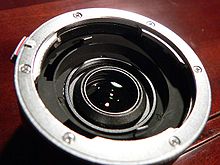Bayonet lock
A bayonet lock is a mechanical connection that can be quickly established and released between two cylindrical parts along their longitudinal axis. The parts are connected by plugging into one another and turning in the opposite direction and thus separated again.
functionality
The part that is pushed over the other has a longitudinal slot, at the end of which a short transverse slot starts at right angles. The other part, on the other hand, has a button which is inserted into the transverse slot and then causes the fixed connection.
The connection is made using a plug-and-turn movement: the two parts to be connected are nested; Elongated elevations are made in both parts at the connection point approximately perpendicular to the insertion direction. However, these do not run all around, but are interrupted (otherwise it would not be possible to plug them together). Since the elevations are now slightly inclined in the plane perpendicular to the direction of insertion, both parts are pressed against each other by a rotary movement. The bayonet lock works like a thread. Sometimes (for example with camera lenses) a catch is also used to secure the connection . As an alternative to moving the interlocking rails, a correspondingly shaped indentation on one part and a bulge on the other part can also be used (e.g. with BNC connectors ).
history
The bayonet lock was initially used to firmly connect the bayonet (French, after the city of Bayonne), a thrust weapon attached to the front part of the rifle , to the rifle. In this way, if necessary (e.g. during close combat), the bayonet could be "planted" using the bayonet lock; there is a separate command for this: “The side gun raises up!”.
use
The way bayonet locks work is based on the type of connection with which bayonets were originally attached to the rifle. The bolt movement itself is reminiscent of the repeating movement of the rifle bolt according to Mauser (Enfield etc.).
Bayonet locks can be found today, for example, on:
- Interchangeable lenses for photographic cameras , see lens mount
- Plug connections for cables ( BNC connector , ST connector )
- Packaging of CDs and DVDs ( cakebox )
- Espresso machines
- Light bulbs to car - headlights
- Special lamps
- Fuel caps for automobiles
- Necklaces
The hose couplings on standardized German fire hoses are also to be coupled together exclusively using a bayonet lock principle. The coupling system used here is called the Storz coupling .
In Great Britain and some Commonwealth countries , B22d bayonet sockets in addition to E27 swivel bases are also common for connecting incandescent lamps (220/230 V) .
For a detailed description of the use in lamps, see bayonet base .
literature
- Hans Rudolf Ris: Lighting technology for practitioners. 5th edition, Electrosuisse, Fehraltorf 2011, ISBN 978-3-905214-71-0 .
- Wilhelm Gerster: Modern lighting systems for indoors and outdoors. Compact Verlag, Munich 1997, ISBN 3-8174-2395-0
- Rudolf Hüppen, Dieter Korp: Car electrics all types. Motorbuchverlag, Stuttgart 1968, ISBN 3-87943-059-4
- Günter Springer: Expertise in electrical engineering. 18th edition, Europa-Lehrmittel, Wuppertal 1989, ISBN 3-8085-3018-9



